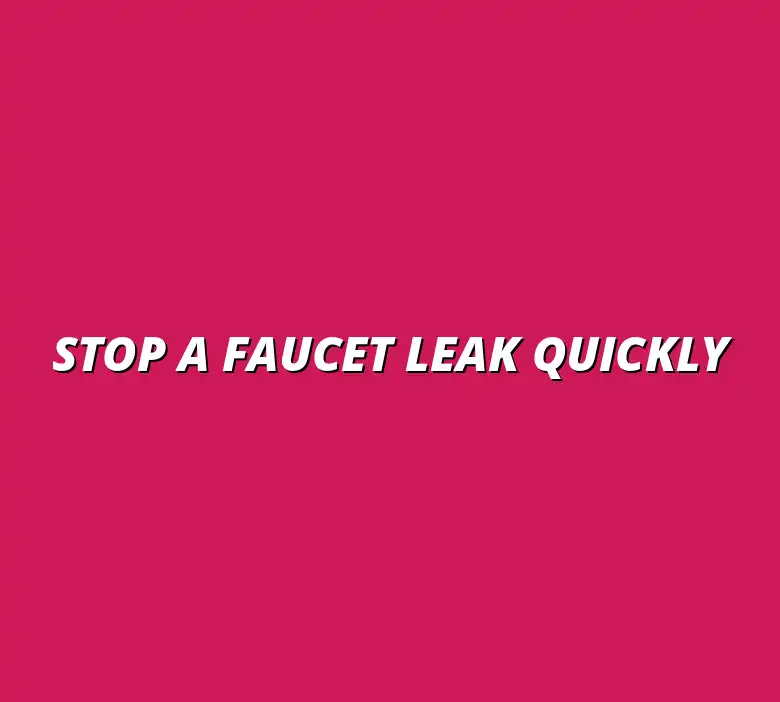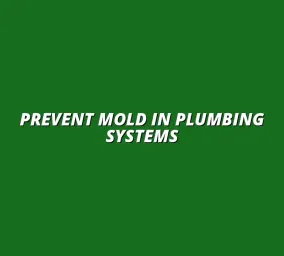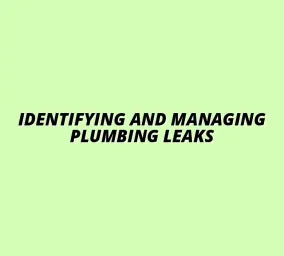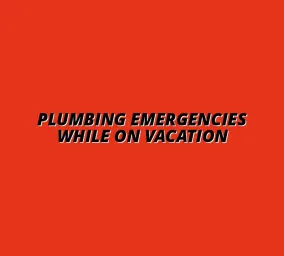Stop a Faucet Leak Quickly
Understanding the Causes of Faucet Leaks in Emergency Situations
When a faucet starts to leak, it can be quite a distressing situation, especially if you're not prepared. Understanding the causes of faucet leaks is vital to preventing further damage and ensuring quick repairs. In an emergency situation, knowing what might be wrong can save you time and frustration.
Faucet leaks often occur due to several reasons that are common across households. By identifying these common causes, you can effectively troubleshoot the issue and take necessary actions. Let’s delve into some of the primary reasons why faucets leak.
Common Reasons for Faucet Leaks
Faucets can leak for a variety of reasons, and recognizing these can help in resolving the issue quickly. Here are some of the most frequent causes:
- Worn Out Washers and O-Rings
- Corroded Faucet Components
- Loose Faucet Connections
Worn Out Washers and O-Rings
One of the most common causes of leaks is worn out washers and O-rings. These tiny rubber components help form tight seals in your faucet. Over time, they can become brittle or cracked, leading to leaks that can waste a significant amount of water.
If you notice dripping from the faucet, especially when it’s turned off, it’s a good idea to check these parts first. Replacing them is usually a simple fix and can restore your faucet's functionality quickly! For more DIY tips on fixing a leaky faucet, check out this helpful guide: Fix Your Leaky Bathroom Faucet.
Corroded Faucet Components
Corrosion can also lead to leaks, especially in older faucets. If metal parts become rusted or corroded, they can weaken and cause leaks to form. Regularly inspecting your faucet for any signs of corrosion can help catch issues before they escalate.
It's important to note that corroded components may require replacement, so keep an eye out for any discoloration or pitting on the metal surfaces.
Loose Faucet Connections
Loose connections are another culprit behind faucet leaks. Over time, connections can become loose due to regular use or vibrations. A simple tightening of the connections can often stop the leak immediately.
It’s always a good idea to check all visible connections and fittings. If you find anything loose, tighten them gently to see if it stops the leak. This is an easy fix that can prevent further problems! Knowing the right tools for the job can make a big difference; check out this list of essential plumbing tools for homeowners.
Immediate Steps to Take When Faced with a Leaking Faucet
When faced with a leaking faucet, your first reaction might be panic. However, staying calm and taking a few immediate steps can make all the difference. Assessing the situation and acting swiftly can prevent further damage to your home.
Let’s discuss how to assess the severity of the leak and what you should do next. Understanding whether you can handle it yourself or if you need professional help is crucial in these situations.
Assessing the Severity of the Leak
Before rushing into repairs, it's essential to assess how serious the leak is. Start by identifying the source of the leak; is it dripping steadily, or is it just a small trickle? Here are some steps to help you:
- Look for visible leaks: Check if there are any visible water spots around the faucet.
- Listen for drips: A constant dripping sound can indicate a more serious issue.
- Check the water pressure: If the water pressure has suddenly dropped, it could signal a bigger problem.
Identifying the Source of the Leak
To effectively manage a leak, pinpointing its source is essential. Inspect all the components of the faucet, including the handle, spout, and base. If you can find out where the water is coming from, it’ll be much easier to take the right steps to fix it.
Sometimes, leaks originate from hidden connections or the plumbing behind the wall, so be thorough in your investigation!
Determining Whether You Need Professional Help
Not every leak requires a plumber, but knowing when to call one can save you time and money. If the leak is minor and you can manage it with some DIY fixes, then go for it! However, if you notice:
- Widespread water damage
- Persistent leaks despite efforts to fix
- Strong odors or mold growth
Then it’s time to reach out to a professional. For plumbing emergencies in Bournbrook, Birmingham, consider contacting a plumber in Bournbrook, Birmingham. They can address the problem effectively and ensure your plumbing is in top shape.
Shutting Off the Water Supply
In many cases, turning off the water supply is the first and most important step to take. This helps prevent further water damage while you evaluate and fix the leak. Knowing how to locate and use your water supply valves can be a lifesaver!
Let’s go over how to find the main water valve and any individual faucet valves that might help. It’s a simple process that can make a big difference!
Locating the Main Water Valve
The main water valve is usually located near where the water line enters your home. It may be in a basement, crawl space, or even outside. Knowing where it is before an emergency occurs can save you a lot of hassle!
To turn it off, simply twist the valve clockwise until it stops. This action stops all water flowing into your home, giving you peace of mind while you address the leak.
Turning Off Individual Faucet Valves
If the leak is localized to a specific faucet, you can turn off the individual faucet valve instead of the main supply. These valves are typically located beneath the sink and can be turned off by twisting them clockwise.
This will allow you to work on the faucet without affecting the rest of your plumbing. It’s a handy solution for quicker repairs! Dealing with a leaky kitchen sink requires a slightly different approach.
Minimizing Damage from the Leak
Once the water is turned off, it’s crucial to minimize any damage caused by the leak. Water can quickly lead to issues like mold and structural damage if not managed properly. Taking proactive steps can help protect your home!
Here are some strategies to contain the leak and minimize damage:
- Using towels: Lay towels or rags around the area to absorb dripping water.
- Using buckets: Place buckets under the faucet to catch any remaining drips.
- Moving valuables: Relocate any items that could be damaged by water.
Using Towels and Buckets to Contain Water
Simple items like towels and buckets can be incredibly effective in containing water. By soaking up the excess moisture, you can significantly reduce the chance of water damage. Make sure to check and replace any soaked towels regularly!
While this is a temporary measure, it’s important to keep the area as dry as possible while you work on fixing the leak.
Preventing Water Damage to Surrounding Areas
To further prevent damage, be mindful of the surrounding areas. If the leak is severe, consider using a wet/dry vacuum to remove standing water. Keeping the area dry will help prevent mold and other potential issues. Knowing how to repair a burst pipe quickly is also crucial in preventing extensive water damage.
Remember, addressing a leak promptly not only saves water but also protects your home from costly repairs down the line!
Long-Term Solutions to Prevent Future Faucet Leaks
Preventing faucet leaks isn't just about quick fixes; it involves implementing effective long-term solutions. By taking proactive measures, you can ensure your faucet remains in good working condition. Let's explore some strategies that can help you avoid those frustrating leaks in the future!
Regular Maintenance and Inspection of Faucets
One of the best ways to prevent future faucet leaks is through consistent maintenance and inspection. Regularly checking your faucets allows you to catch any signs of wear and tear before they turn into bigger problems. Here are some key aspects to consider during your inspections:
- Check for drips or pooling water around the faucet base.
- Look for rust or corrosion on faucet components.
- Inspect washers and O-rings for cracks or wear.
Identifying Signs of Wear and Tear
Being vigilant about potential issues can save you time and money. Common signs of wear include:
- Unusual sounds, like hissing or rattling.
- A decrease in water pressure.
- Changes in the flow of water, such as sputtering.
Noticing these signs early can help you address them before they lead to a leak. Preventing frozen pipes this winter is another important preventative measure.
Scheduling Periodic Professional Inspections
While DIY maintenance is essential, having a professional inspect your faucets at least once a year can provide peace of mind. Professionals can identify hidden issues that you might miss. They can also help with:
- Recommending upgrades for old fixtures.
- Performing thorough checks on plumbing systems.
- Replacing worn-out parts before they fail.
Choosing Quality Faucet Components
Investing in high-quality faucet components can significantly reduce the risk of leaks. Cheaper materials may save you money upfront, but they can lead to costly repairs down the line. By choosing durable and reliable parts, you ensure your faucet stands the test of time.
Understanding the Importance of Durable Materials
Not all faucet components are created equal. Durable materials prevent corrosion and wear, which can lead to leaks. When selecting faucets, look for:
- Brass or stainless steel bodies.
- High-quality ceramic discs.
- Rubber O-rings that resist cracking.
Investing in Reliable Brands and Products
It's wise to choose reputable brands that have a history of quality. Reliable manufacturers often offer warranties and customer support, giving you additional confidence in your purchase. Some brands to consider include:
- Kohler
- Moen
- Delta
By doing a bit of research, you can find a product that meets your needs and reduces the chance of leaks. Addressing a leaking water heater pipe also requires prompt attention.
Addressing Common Questions about Faucet Leaks
Faucet leaks can be confusing, and you may have questions about how to handle them. Let's take a look at some common inquiries and provide clear answers to help you figure things out!
What Should You Do if Water Starts Leaking from the Faucet Handle?
If you notice water leaking from the faucet handle, it's essential to act quickly. Addressing the issue promptly can prevent further damage to your plumbing and fixtures. Here’s what to do:
- Turn off the water supply to prevent excess water flow.
- Inspect the handle for loose screws or parts.
- Check if the O-rings or washers need replacing.
Immediate Actions to Take
By taking swift action, you can minimize damage and fix the issue efficiently. After turning off the water, remove the handle and check for any visible damage. If you find worn components, replacing them can stop the leak!
Possible Causes of Leakage at the Handle
Various factors can lead to a leak at the handle, including:
- Worn O-rings that create gaps.
- Corroded screws that prevent a tight seal.
- Improper installation of the handle itself.
Understanding these causes can help you prevent future leaks!
When is it Essential to Call a Plumber?
Sometimes, a leak may be beyond your skill level. If you’re unsure about the severity or how to fix it, calling a plumber is a smart choice. But how do you know when it's time to seek professional help?
Signs Indicating a Professional is Needed
Here are a few signs that it's time to call a plumber:
- Persistent leaks despite DIY fixes.
- Water pooling under the sink or on the floor.
- Low water pressure or strange noises from the faucet.
Understanding the Risks of DIY Repairs
While DIY repairs can save money, they also come with risks. Potential issues include:
- Causing more damage if repairs are done incorrectly.
- Injuries from sharp tools or slippery surfaces.
- Wasting time and resources on ineffective fixes.
Weighing these risks can help you decide the right course of action!
Final Thoughts on Managing Faucet Leaks
In summary, managing faucet leaks requires a proactive approach. Regular maintenance, quality components, and knowing when to call a professional can significantly reduce the chances of leaks. Trust me, taking these steps will save you from frustration and unexpected repair bills!
Summary of Steps to Take During a Leak Emergency
When faced with a faucet leak, remember to:
- Assess the severity of the leak and locate its source.
- Shut off the water supply to minimize damage.
- Consider temporary solutions until a permanent fix is possible.
Encouragement to Maintain Faucets Regularly for Prevention
Don't wait for a leak to occur before you take action! Regularly inspecting and maintaining your faucets will help you avoid potential issues down the line. Take charge of your plumbing today, and enjoy a worry-free experience with your faucets!






